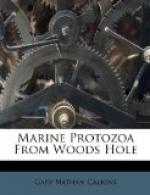The body is elongate, lancet-shaped, with a tapering anterior extremity. The dorsal outline is concave through the bending of the anterior end, while the ventral outline presents an even, convex curve. The mouth lies slightly above the center of the body and marks the posterior limit of the ventral peristomial groove, which curves slightly from the anterior extremity. Each side of this groove bears an undulating membrane, the left being much larger and conspicuously striated. The general form of this left membrane is triangular, the widest part is anterior, the narrowest at the mouth. The right membrane is similar in form, but smaller and more active. The endoplasm is colorless and finely granular, not regionally differentiated. The ectoplasm consists of a relatively thick cortical plasm specially noticeable in the posterior half of the body and a delicate cuticle which bears almost imperceptible longitudinal markings—the insertion points of the fine cilia. The body is covered with uniform cilia except at the anterior extremity. Here they are much larger and bristle-like. I was unable to find any cilia in the peristome. One long caudal bristle, one-quarter of the length of the body, trails out behind. The macronucleus is spheroidal and placed near the center of the body; a conspicuous micronucleus lies near it. A row of contractile vacuoles extends from the posterior end. I have seen as many as six of nearly equal size and one or two smaller ones. The intervals of contraction are quite long. Length 70 to 75 mu; greatest diameter 10 to 12 mu.
L. infusionum resembles L. elongatus in its general form and in its mode of life, for it excavates a retreat in zoogloea masses and lies there for considerable periods perfectly quiet. It differs from L. elongatus and from L. velifer (probably the same as L. elongatus of Claparede & Lachmann) in the presence of the caudal bristle, in the absence of annular markings, number of contractile vacuoles, and in the slightly smaller size. It resembles Lembus verminus (Mueller) as described by Kent (Proboscella vermina), and L. intermedius as described by Gourret & Roeser (Lembus verminus syn.)in the absence of annular markings and in the presence of a caudal bristle. It differs from the former, however, in the absence of a tentacle-like process, and from both in the absence of a double nucleus and in the presence of many vacuoles. These features are so characteristic of all the specimens examined that I have concluded, somewhat reluctantly, to give it a specific name. It is common in old infusions of algae, especially after decomposition is well advanced. Its food consists of bacteria.
[Illustration: Fig. 42.—Lembus infusionum.]
Lembus pusillus Quennerstedt 1869. Fig. 43.
Synonym: L. subulatus Kent 81.




